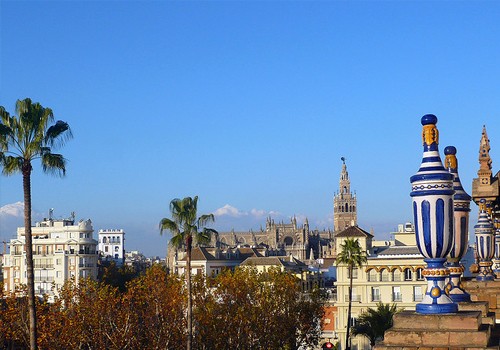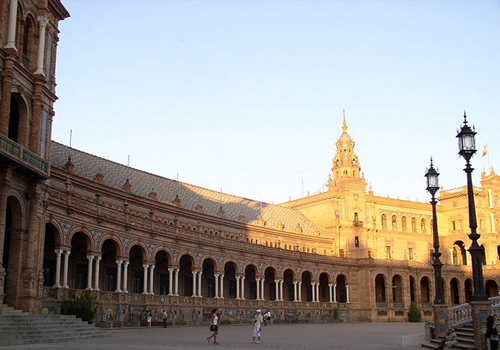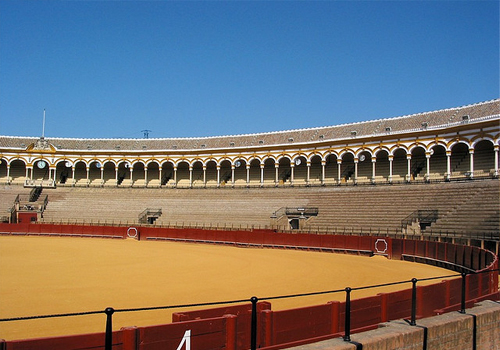Seville Travel Guide
Seville Cathedral
Address: Avenida de la Constitucion. Seville
Admission: €8 (general); €3 (reduced); free for Seville residents and children under 16. Monday 11am to 3.30pm, Tuesday to Saturday 11am to 5pm, Sunday 2.30pm to 6.30pm (September to June); Monday 9.30am to 2.30pm, Tuesday to Saturday 9.30am to 4.30pm, Sunday 2.30pm to 6.30pm (July and August).
Telephone: +34 95 421 4971
As a monument to Christian glory, Seville's cathedral has few equals, in fact it is still undecided whether it is the largest church in the world when measured against St Peter's in Rome and St Paul's in London. This massive Gothic edifice took more than a century to build, after a group of religious fanatics decided in 1401 to build a church so wonderful that 'those who come after us will take us for madmen'.<br /><br /> The cathedral was built on the site of the Almohad mosque, which was demolished to make way for it, leaving no more than the minaret, built in 1198, known as La Giralda, which is today open to tourists to climb. Along with the Alcazar and the Archivo de Indias, the cathedral has been declared a UNESCO World Heritage Site and is undoubtedly one of the highlights of a visit to Seville. The interior of the cathedral contains some marvellous sights in its 44 chapels, including mahogany choir stalls made from recycled Austrian railway sleepers. It is claimed that Christopher Columbus' remains are here in a tomb dedicated to him, but there is some controversy over this. Artworks to be seen include gilded panels, glittering icons, and intricately carved altar pieces. The cathedral is imposing and quite overwhelming in its scope, but the intricate detail is also incredible.<br /><br />
Alcazar of Seville
Address: Plaza del Triunfo Seville
Admission: €8.50 Open daily 9.30am to 5pm (October to March) and 9.30am to 7pm (April to September).
Telephone: +34 95 450 2323
Alcazar is Seville's top attraction and one of the most famous attractions in Spain. The palace complex is a UNESCO World Heritage Site and an undisputed architectural masterpiece by any standards. The site of Seville's Moorish Alcazar palace has been occupied by the city's rulers since Roman times, and has been a favoured residence of Spanish kings since the Middle Ages.<br /><br /> The palace was established by the Moors as early as the 7th century, although it was primarily built in the 1300s, and has been added to and altered by successive occupants ever since. First to enlarge the building was the infamous al-Mu'tadid of the Abbadids, who reputedly kept a harem of 800 women and decorated the terraces with flowers planted in the skulls of his decapitated enemies. Of the early Christian additions most notable is the colonnaded quadrangle of the Patio of the Maids.<br /><br /> The golden-domed Salon de los Embajadores was a wing built by Fernando and Isabel, and was where the royal pair welcomed Columbus back after his discovery of America. The palace is set in beautiful, extensive gardens where it is possible to picnic if you bring your own food. Otherwise, there is a small restaurant overlooking the gardens. Visitors should allow several hours to explore this spectacular palace complex.<br /><br />
Santa Cruz
Address: Seville
Visitors usually need to visit a tourist office to obtain a detailed map of the winding alleys, gateways and courtyards of this enchanting and fascinating section of Seville, a former Jewish ghetto, where every street corner has a romantic legend attached to it. The balconies and windowsills are all festooned with flowers and the fragrance of jasmine pervades the air in this picturesque corner of the city, which can be reached via the Calle Rodrigo Caro. Santa Cruz is also bordered by the Alcazar, the Jardines de Murillo, and Santa Maria La Blanca. Some of the sights to look for are the Hospital de los Venerables, which contains Sevillian art works; the beautiful mansions in the Calle Lope de Rueda; the Convent de San Jose, which boasts relics of Saint Teresa of Avila; and the Iglesia de Santa Maria la Blanca, which features Murillo's 'Last Supper'. Apart from many notable buildings, the neighbourhood is home to numerous quaint and quirky shops, art galleries, artisans workshops, hotels, guest houses, tapas bars and restaurants, making it a tourists' paradise. Santa Cruz is also a favourite haunt for locals though, and the area is fun to visit during the day and at night. Many walking tours of the district are available and joining one makes for a good introduction to Santa Cruz.<br /><br />
Museo Provincial de Bellas Artes de Sevilla
Address: 9 Plaza del Museo. Seville
Admission: €1.50; free for visitors with EU passports. Tuesday to Saturday 10am to 8.30pm, Sundays 10am to 5pm (16 September to 31 May); Tuesday to Saturday 9am to 3.30pm, Sundays 10am to 5pm (1 June to 15 September). Closed Mondays.
Telephone: +34 95 422 1829
A restored convent, dating back to 1612 and hidden in a tiny plaza off Calle de Alfonso XII in Seville, houses one of Spain's most important and largest art collections. The museum was established in 1839, and houses art spanning from medieval times to the 20th century, with the pride of the collection being the range of paintings from the 17th century, Seville's Golden Age. Highlights include the religious paintings of Seville's own Esteban Murillo, but the collection also includes other Seville School artists such as the macabre works of Juan de Vales Leal and Francisco de Zurbaran.<br /><br /> There are also two paintings by El Greco among the exhibits. The museum has a surfeit of religious art, which will delight some and bore others; it is probably not the best attraction for children. The convent is an incredible housing for the collection, and would be worth exploring even if it were empty, with frescoes and ornate vaulted ceilings that make it hard to tell where the building ends and the art begins. On Sundays there is usually an art market in the square outside the museum where local artists set up stalls and sell their work. A must for art lovers, this gallery is generally considered to have the second best collection of Spanish art in the country.<br /><br />
Maria Luisa Park
Address: Seville
Regarded as one of the loveliest parks in Europe, this half-mile area in southern Seville, near the port, is planted with palms, orange trees, elms and Mediterranean pines. Bright and beautiful flower beds vie for the eye with hidden bowers, ponds, pavilions, water features and statues in this little paradise, which was designed in the 1920s and thus reflects a mix of Art Deco and Mudejar styling.<br /><br /> The park was originally part of Seville's World Expo, which brought a burst of creative architecture and rejuvenation during the 1920s, and which included the re-direction of the Guadalquivir River and the construction of some opulent buildings, like the stylish Guatemala building off the Paseo de la Palmera. Also fronting the park is the city's archaeological museum, focusing on the Romans and prehistory of the province of Seville.<br /><br /> Near the park is the Royal Tobacco Factory (today part of the university), immortalised by the fictional operatic gypsy heroine Carmen, who is said to have worked there. Many of the buildings surrounding Maria Luisa Park are attractions in themselves. The park is a pleasant refuge for relaxation and a stroll, and a great place to have a picnic in Seville.<br /><br />
Ronda
Address: Seville
Admission: 2 hours from Seville by car
Credited both as the birthplace of bullfighting and the home of one of Spain's great architectural feats, Ronda is an easy and entertaining escape from the city. Dramatically situated on the edge of a deep gorge, Ronda is a very picturesque place offering plenty of fodder for photographers. Ambling about the cobbled streets, handsome mansions and well-established artisan boutiques is enough to fill a day, but no visit would be complete without a trip to the beautiful old bull ring and Ronda's most famous attraction, the Puento Nueveo (The New Bridge). The structure straddles a magnificent chasm and connects the old town to the new, while allowing visitors a vista of the region unfolding around them. The Old Town, La Ciudad, is a labyrinth of narrow streets and historic old buildings which is a delight to explore. Calle la Bola is the main shopping street, and La Alameda, right next to the bull ring, is a pleasant park for a rest in the shade. Ronda is small and best explored on foot, with plenty of drinking fountains in the Old Town. Those who have energy to spare can walk down to the bottom of the gorge, which affords great photo opportunities.<br /><br />
Gibraltar
Address: Seville
This large lump of limestone stuck to the end of the Iberian Peninsula is as famous for its bizarre geology as it is for its overly-friendly furry friends. Though many countries have claimed the beacon over the years, it's officially owned by the British government and thus it is advised that tourists exchange Euros for Pounds here for ease and economy. The Rock of Gibraltar is easily conquered by cable car, but it's worthwhile to hire a guide (around 25 USD per person) to explain the countless caves and mites, and to coax the wild monkeys to give a toothy grin while atop your head. On clear days visitors can even view North Africa.<br /><br /> St Michael's Cave, long believed to be bottomless, is a thrilling attraction with many myths and stories attached. Part of the massively deep cave is open to visitors and is even used as a concert venue. The labyrinthine Great Siege Tunnels, an incredible defense system constructed to repel the Spanish and French invaders between 1779 and 1783, is also fascinating. The Moorish Castle complex, dating back to the 11th century, is another impressive attraction in Gibraltar. The fit and brave should consider walking up the steep Mediterranean Steps, which wind up the eastern side of the Rock, providing stunning views, but this hike is not suitable for those afraid of heights!<br /><br />
Sherry Bodegas
Address: Seville
Andalusia's chalky soil is ideal for the cultivation of the palomino grape, from which the world-famous sherry (jerez) of the region is made. The main sites of sherry production in Andalusia are Jerez de la Frontera and Montilla, and these charming towns are home to plenty of self-proclaimed sherry connoisseurs, who will debate the quality of the sweet amber-coloured blends with the seriousness usually reserved for appraising the finest French wines. An increasingly popular tourist activity for visitors to southern Spain is to tour the bodegas of the region, wineries with a history dating back to Roman times, which specialise in the fermentation of palomino grapes and the production of sherry.<br /><br /> Tasting tours of these bodegas are fun and informative, and - especially in the case of Jerez de la Frontera - can be combined with other great cultural attractions, such as checking out a flamenco dance performance, or admiring beautiful Andalusian horses at a dressage event. A bottle of Andalusian sherry makes for a great Spanish souvenir for friends and family back home: visit the bodega of Pedro Domecq and pick up a bottle of their amontillado variety. Many tour operators offer day trips to the bodegas but it is also easy to explore without a guide.<br /><br />
El Rinconcillo
Address: C/Gerona 40 y Alhondigo 2 Seville
Food Type: Spanish
Moorish brickwork, a handsome mahogany bar and a ceiling that dates back to the seventeenth century give El Rinconcillo the kind of old-world charm that other restaurants merely aspire to. As one of the most famous tapas bars in the city, the venue not only claims a rich history, but also remains true to its Andalusian roots and the accompanying relaxed regional demeanour. Visitors can enjoy a full meal or a few light tapas portions. Open daily 1pm to 1.30am.<br /><br />
Restaurante San Marco
Address: Calle Meson del Moro Seville
Food Type: Italian
Styled to appear as a 12th-century Arab bath house, the lively atmosphere and delicious Italian cuisine make this a favourite among both locals and tourists. This particular venue is tucked away among the winding alleyways of Barrio Santa Cruz, but three other options - each uniquely designed - appear in different areas of the city. Reservations are crucial. Dinner is served from 8pm until midnight.<br /><br />
Egana Oriza
Address: San Fernando 41 Seville
Food Type: Spanish
Situated in a bright and airy mansion dating back to 1926, this stylish space allows guests the opportunity to dine in the equivalent of a contemporary indoor garden. The restaurant was once credited with a Michelin star, though nowadays, tapas and drinks are just as much an occasion as haute cuisine. Visitors can look forward to a fantastic wine list and very knowledgeable sommelier. Closed Sundays. Lunch is served 1:30pm to 4pm; dinner from 8:30pm to midnight.<br /><br />
Barbiana
Address: Calle Albaredo 11 Seville
Food Type: Seafood
Seafood specialities have buoyed Barbiana to regular appearances on any of Seville's top restaurant listings. Though the city is inland, the chefs go out of their way to source a fresh selection of succulent shrimp, squid, sea bass and white fish all the way from the coastal town of Cadiz. The restaurant is set in the heart of Seville, adjacent to the Plaza Neuve. Those pressed for time can enjoy an abbreviated version of the menu at the tapas bar in front.<br /><br />
Az-Zait
Address: Plaza San Lorenzo 1 Seville
Food Type: Spanish
Classically Mediterranean and reasonably priced, Az-Zait is your affordable answer to lunch and dinner. Set next to the Convent of San Lorenzo, the restaurant is comfortable, the service good and the cuisine reliable. The menu offers both Andalusian favourites (gazpacho) and more inventive options, like the honey-glazed cuttlefish. There is also a tasting menu available. Lunch is served from 11am to 4:30pm, and dinner from 8pm to 12:30am.<br /><br />
(Data provided outside US and Canada by Foreca, Data provided for US and Canada by WDT)
| Jan | Feb | Mar | Apr | May | Jun | Jul | Aug | Sep | Oct | Nov | Dec | |
| Average High | 61° | 63° | 69° | 71° | 79° | 87° | 95° | 95° | 90° | 78° | 69° | 62° |
| Average Low | 5° | 6° | 7° | 10° | 12° | 16° | 18° | 19° | 17° | 13° | 9° | 6° |
(Data provided outside US and Canada by Foreca, Data provided for US and Canada by WDT)
| Jan | Feb | Mar | Apr | May | Jun | Jul | Aug | Sep | Oct | Nov | Dec | |
| Average High | 16° | 17° | 20° | 21° | 26° | 30° | 35° | 35° | 32° | 25° | 20° | 16° |
| Average Low | 42° | 44° | 46° | 50° | 55° | 62° | 66° | 67° | 64° | 56° | 49° | 44° |
| Description Round pins. |
Voltage 230 V |
Frequency 50 Hz |
Type C |
| Description "Schuko" plug and receptable with side grounding contacts. |
Voltage 230 V |
Frequency 50 Hz |
Type F |


